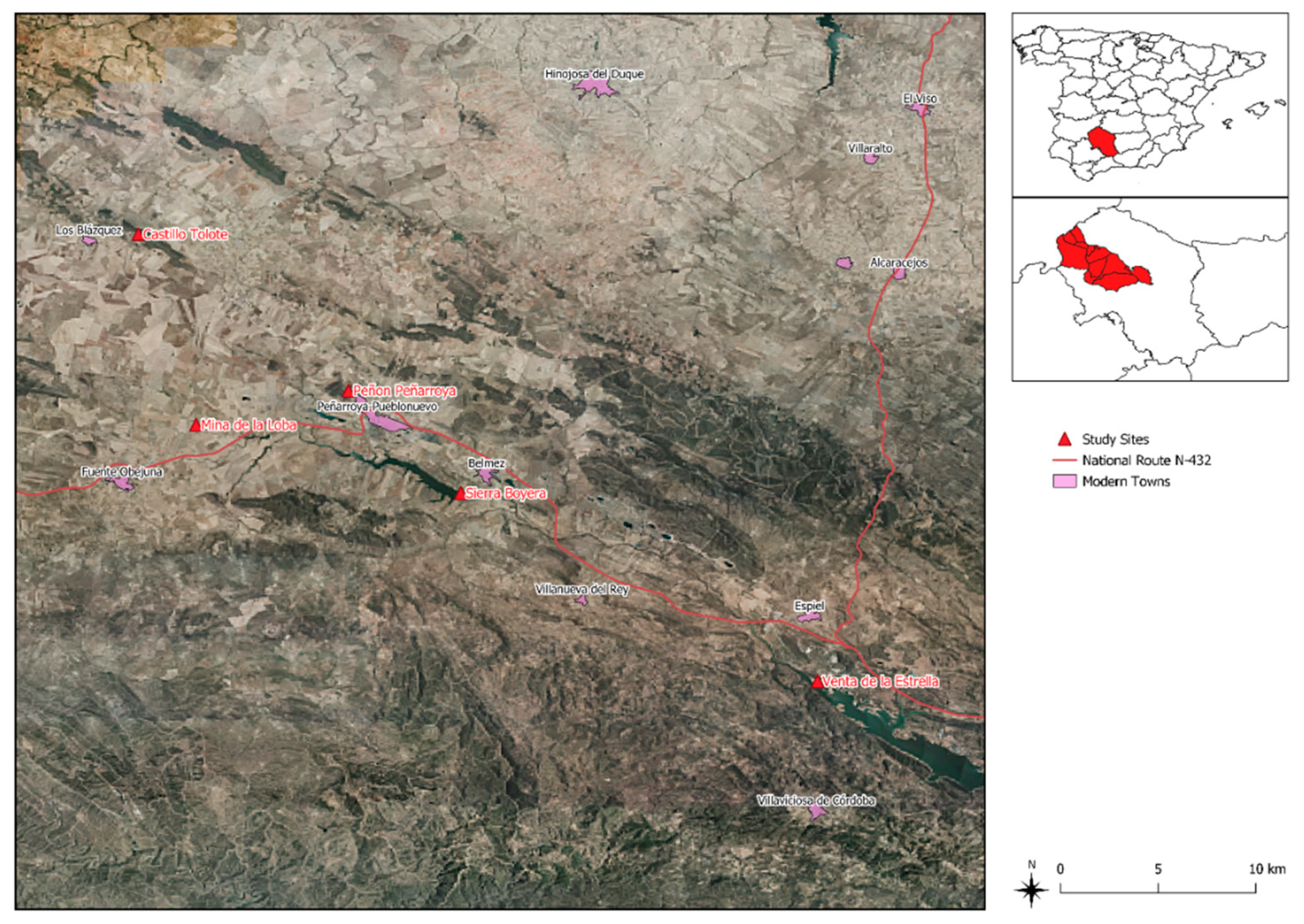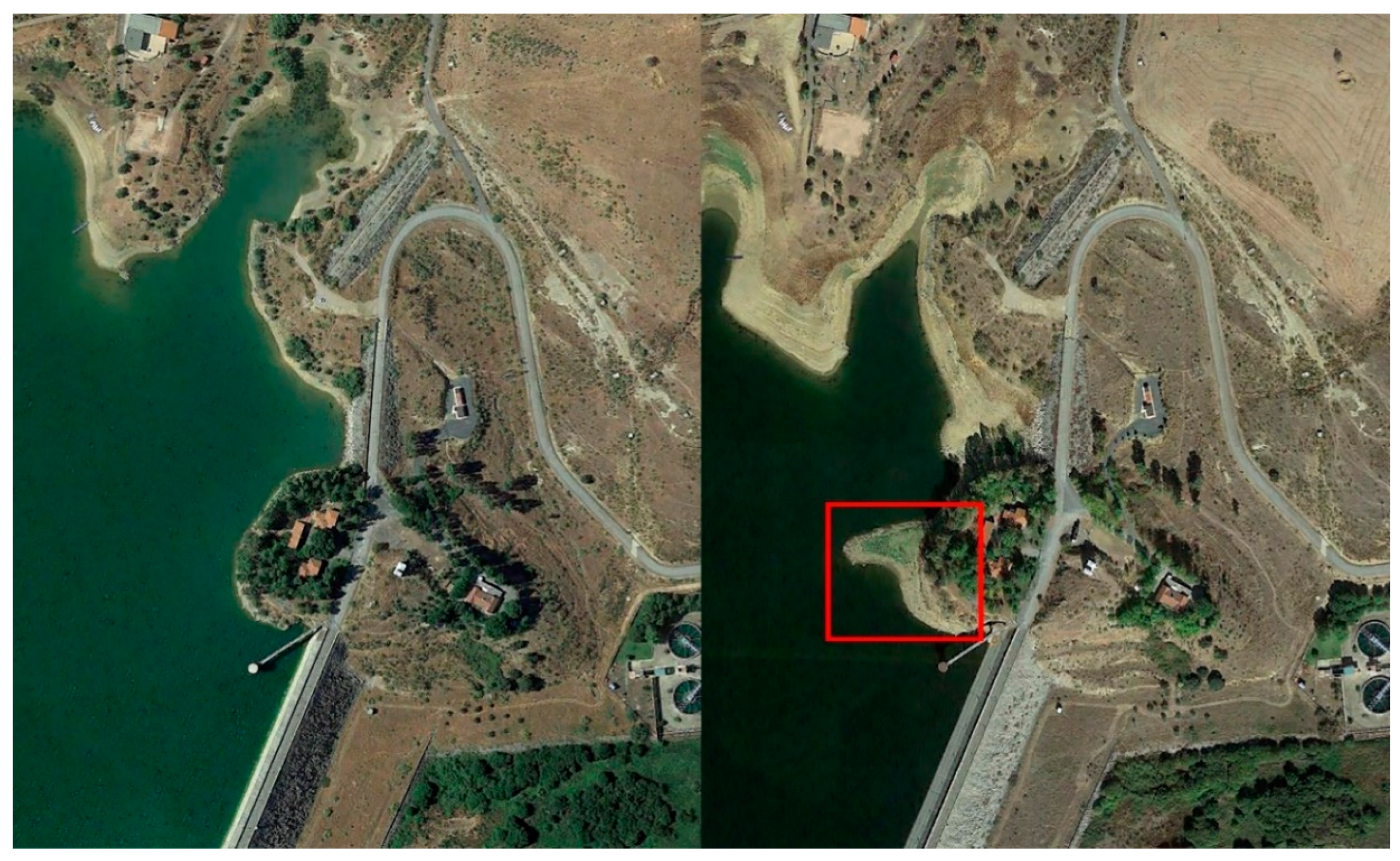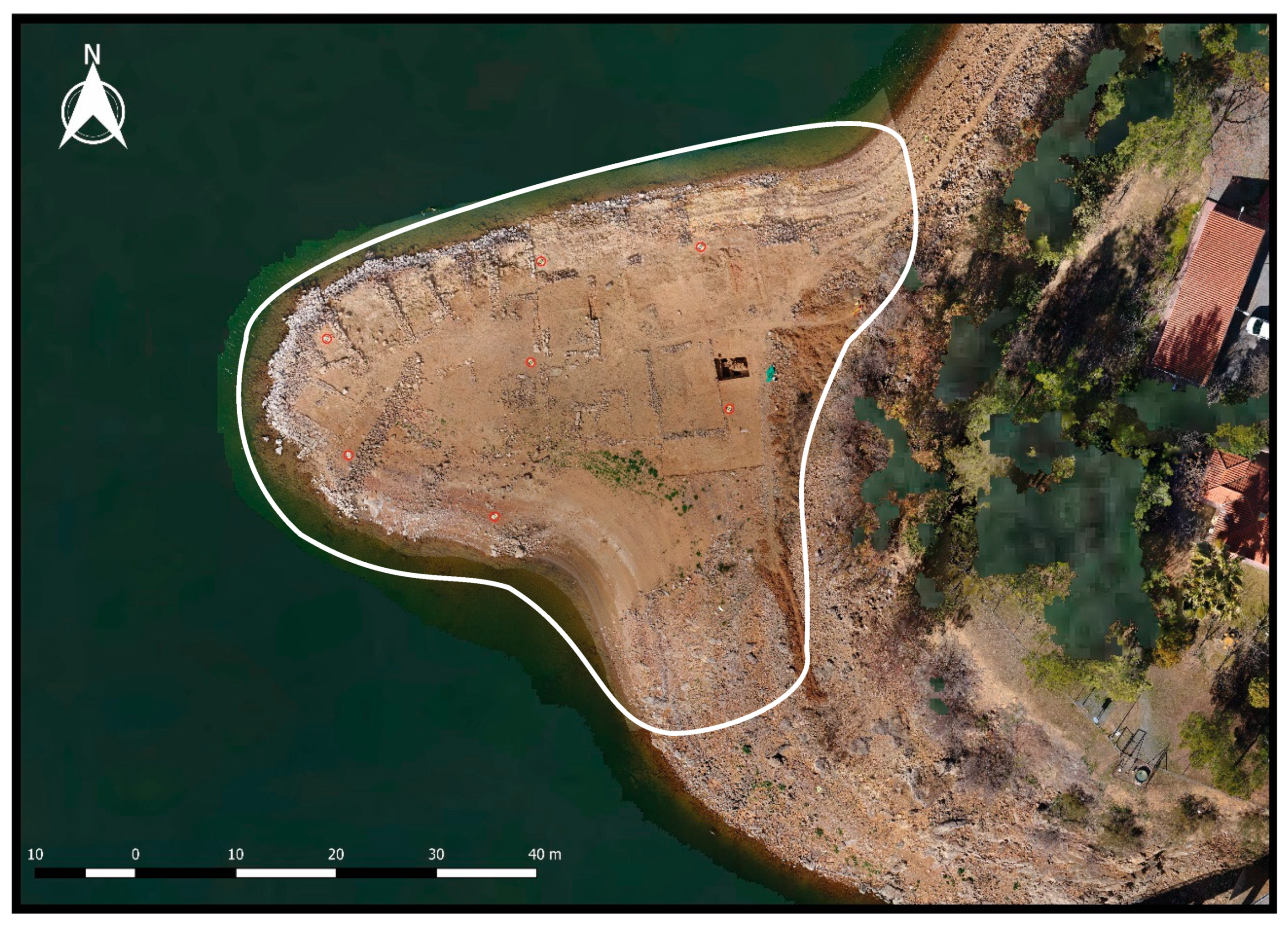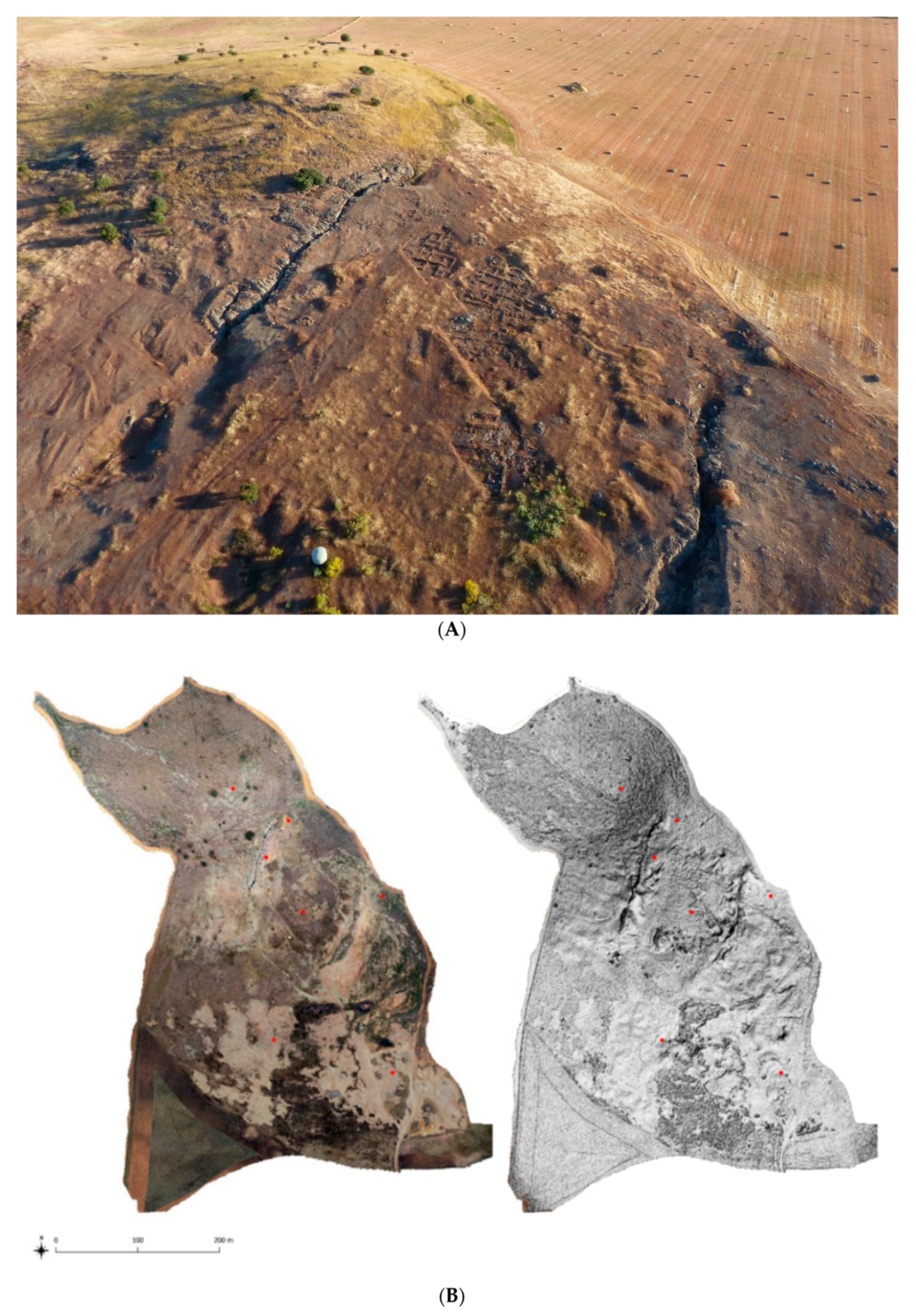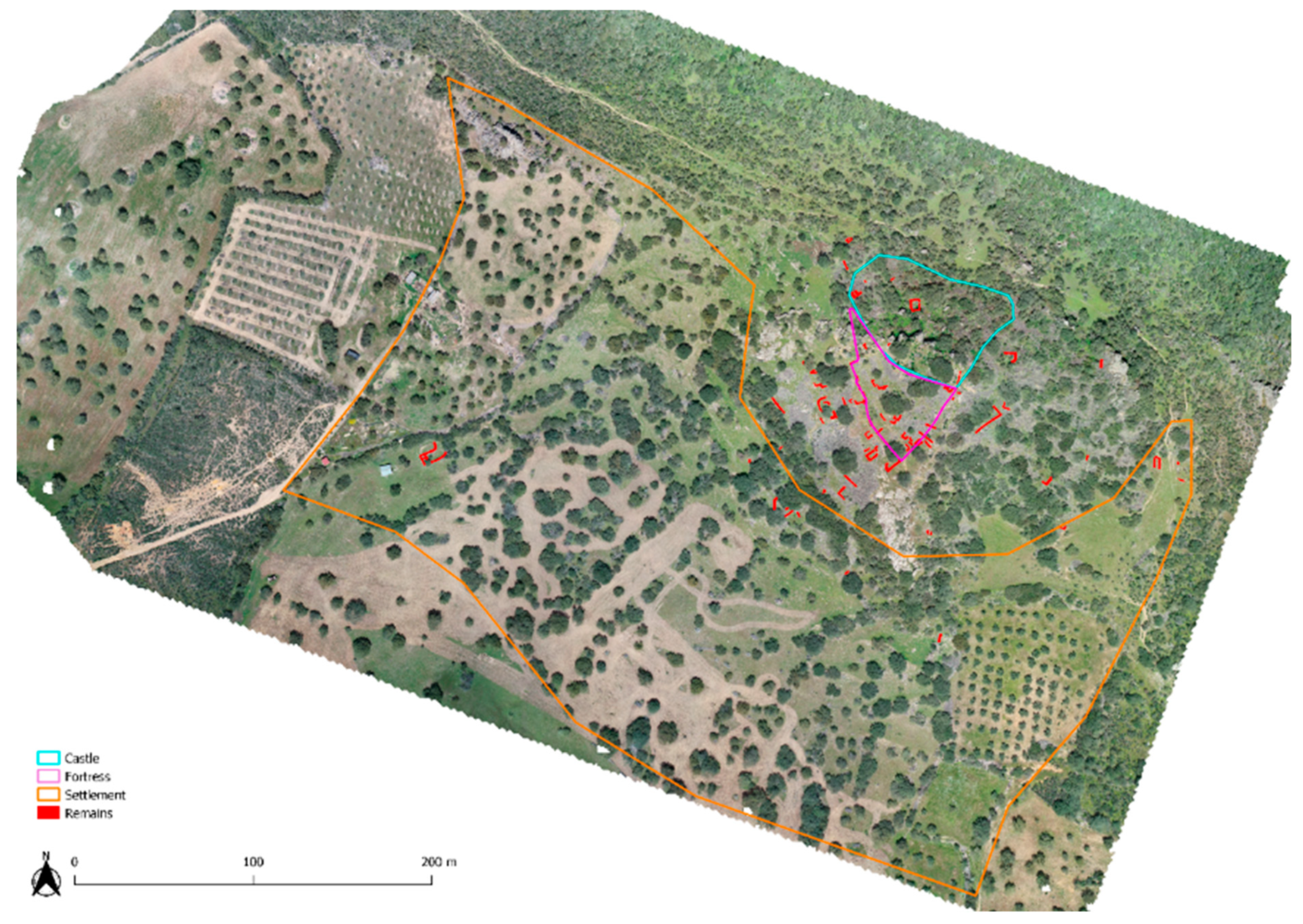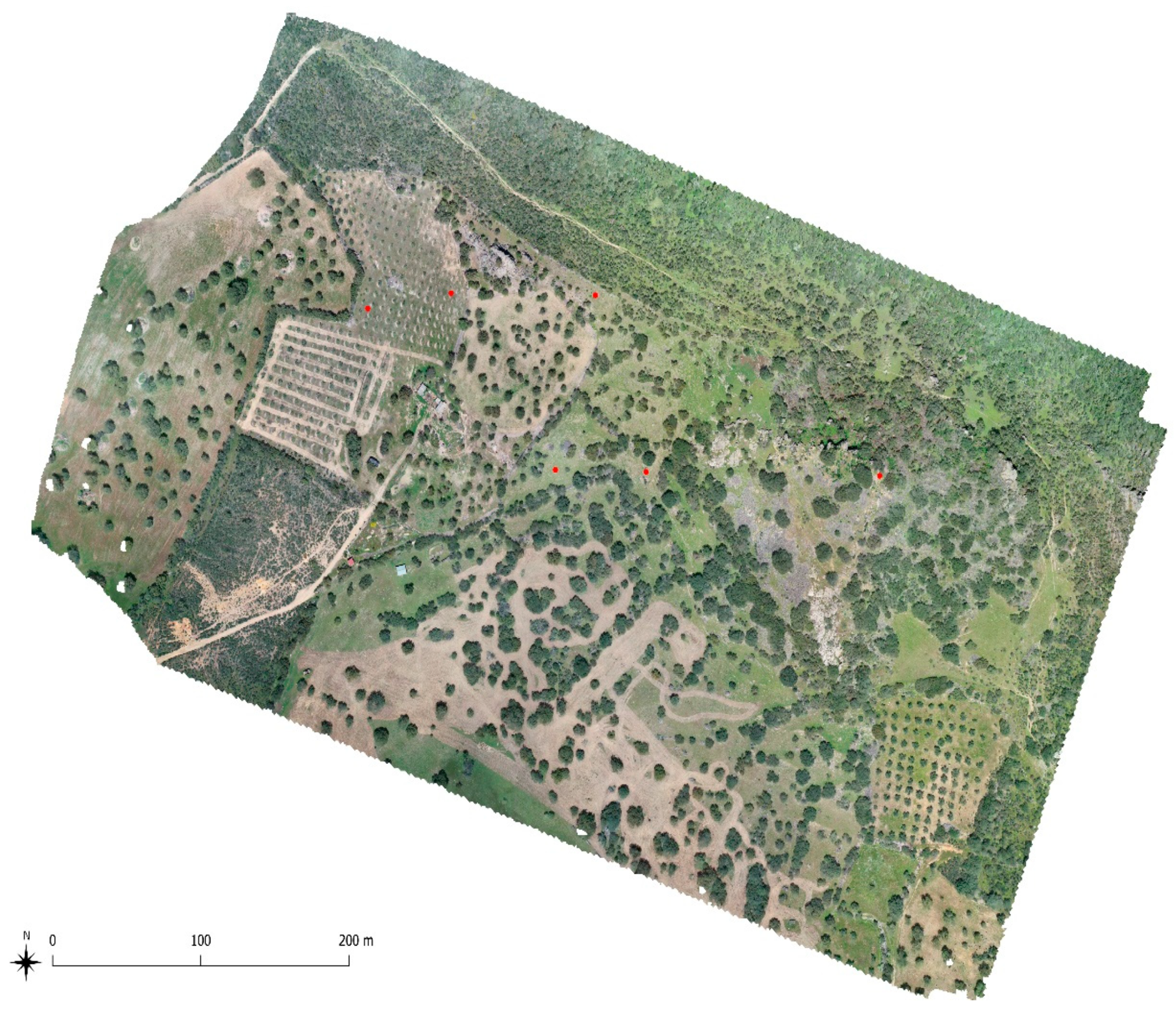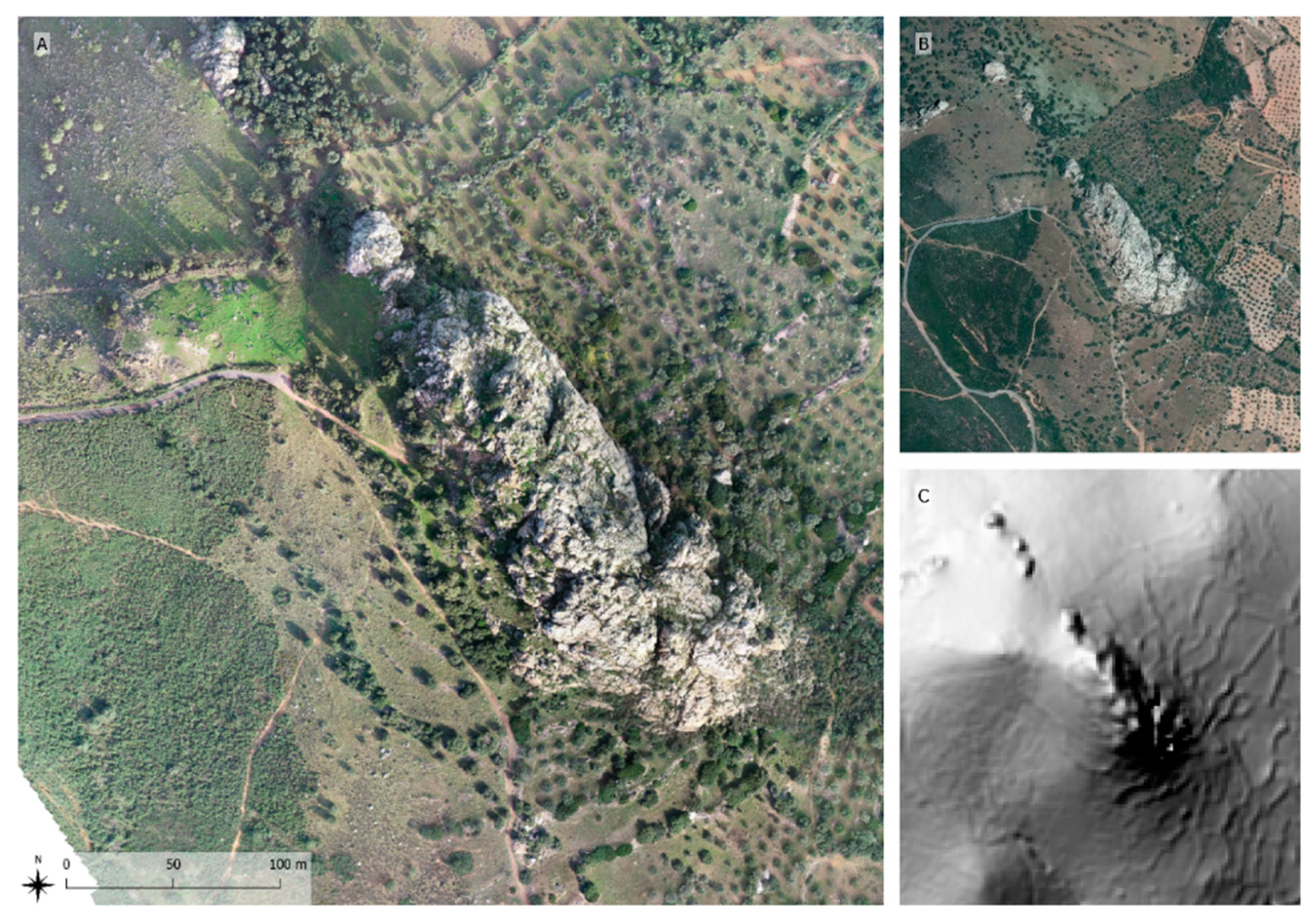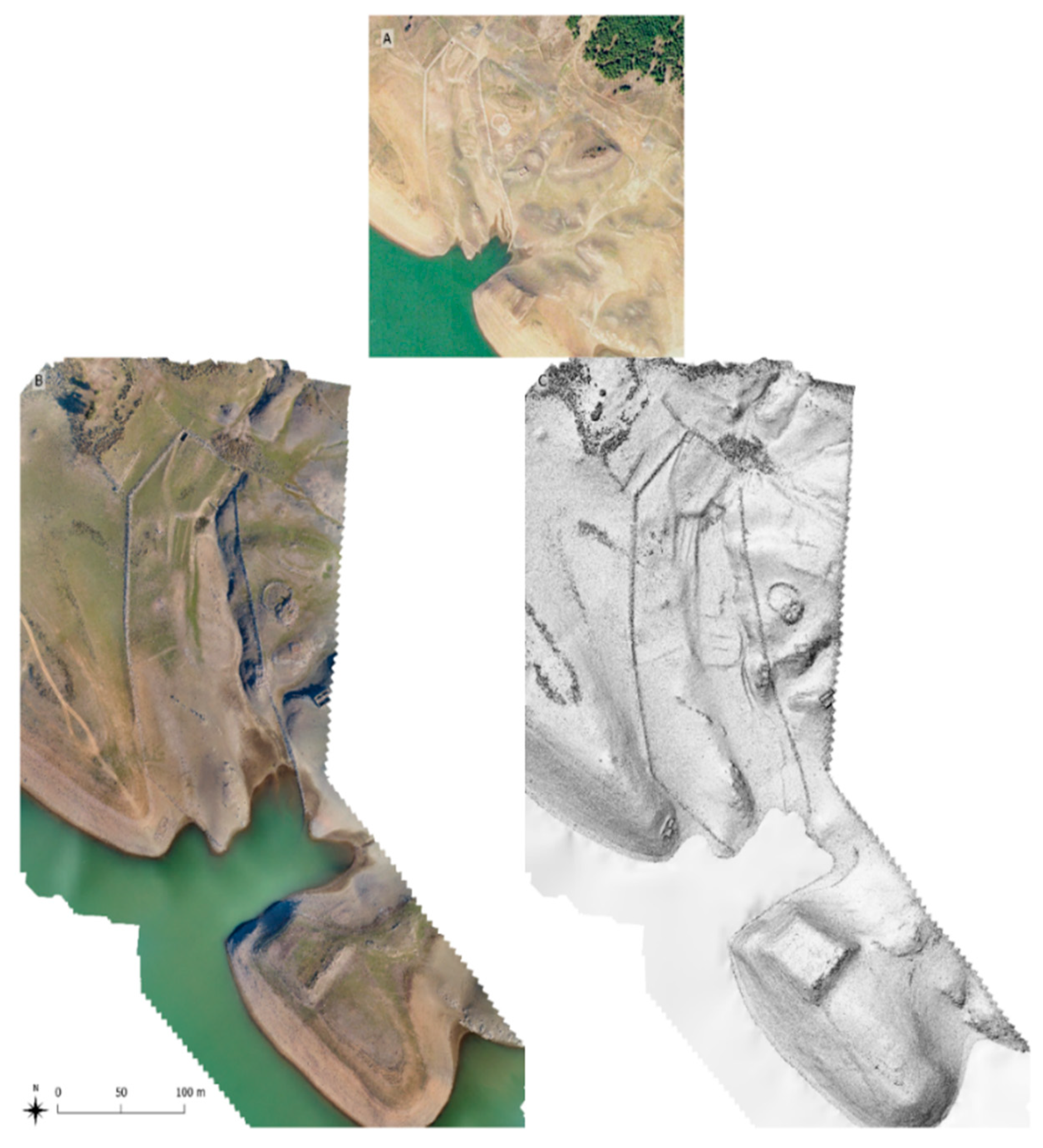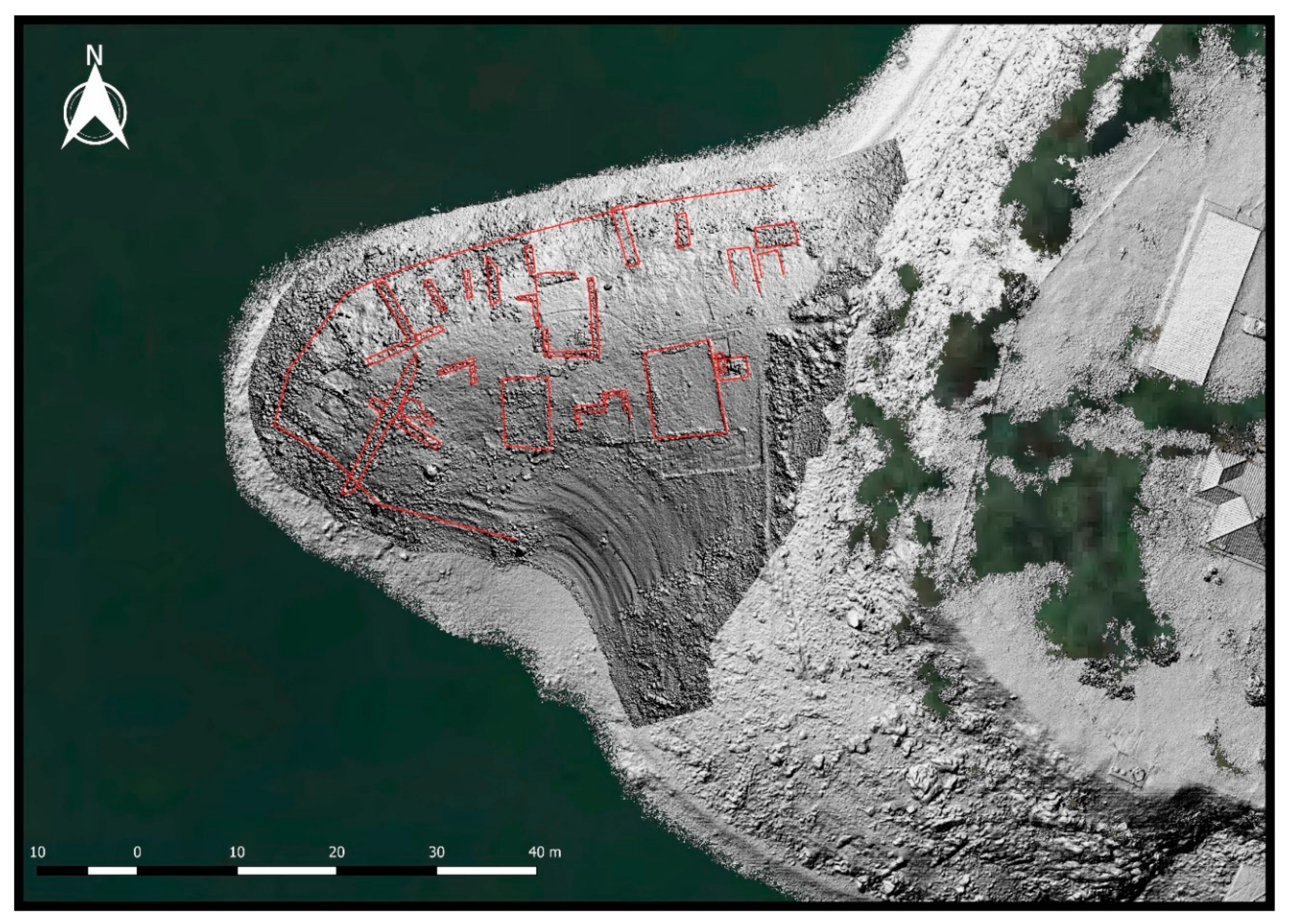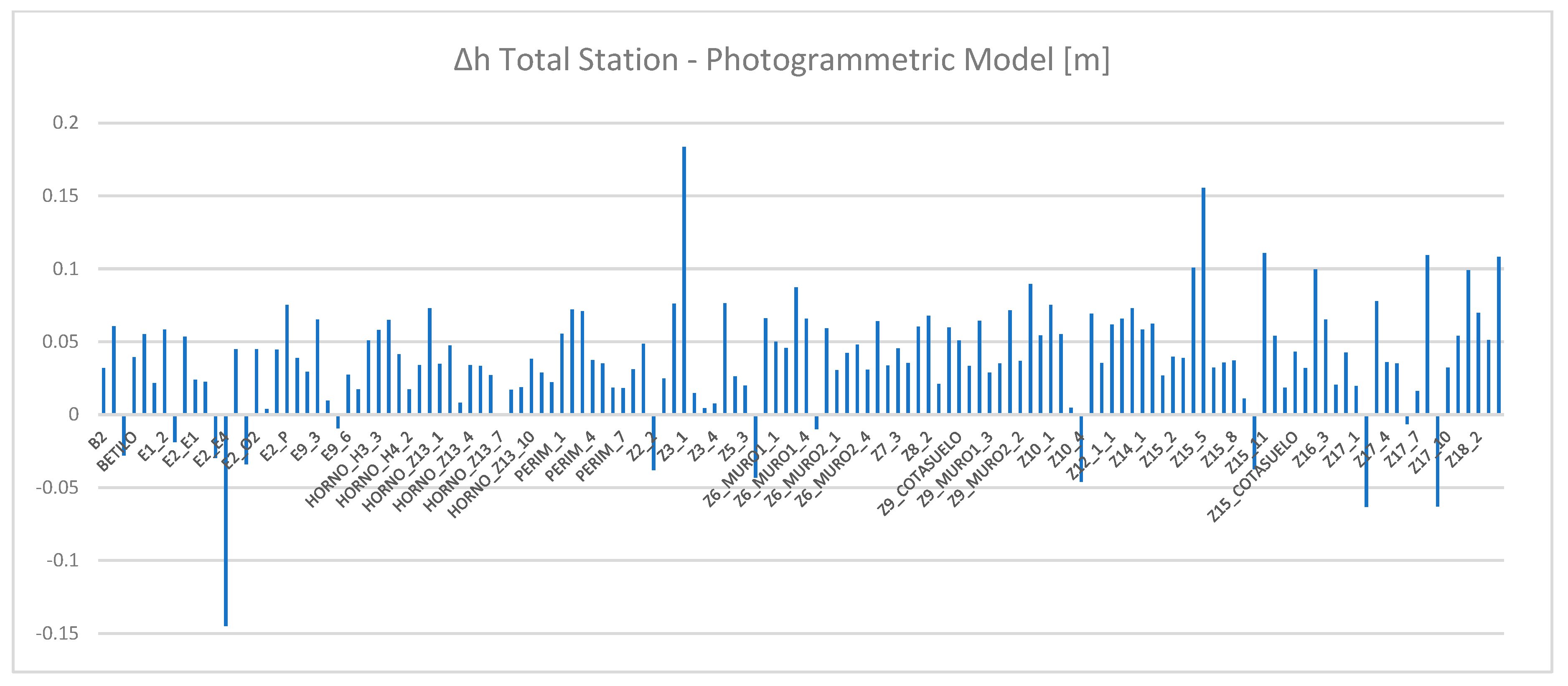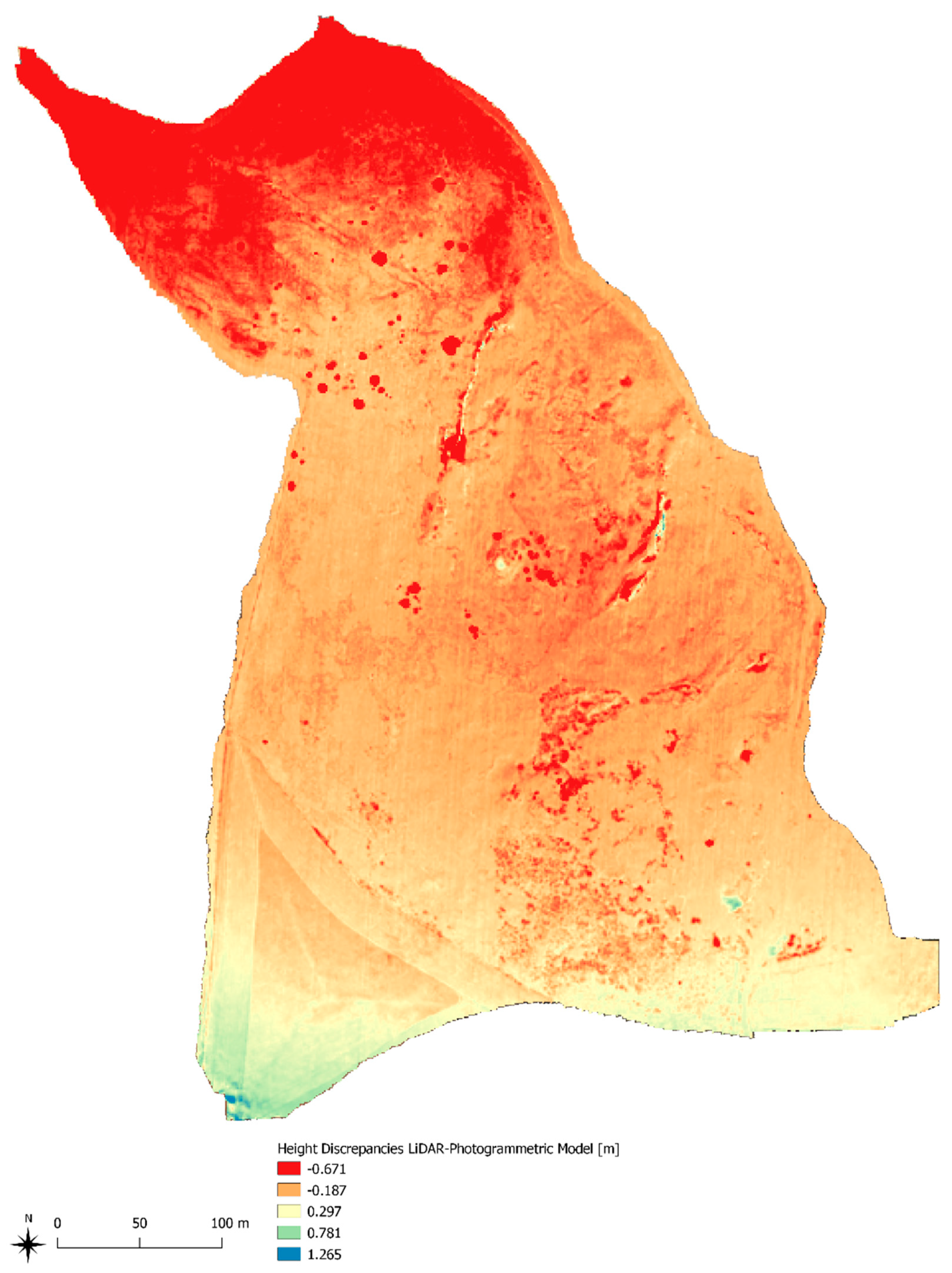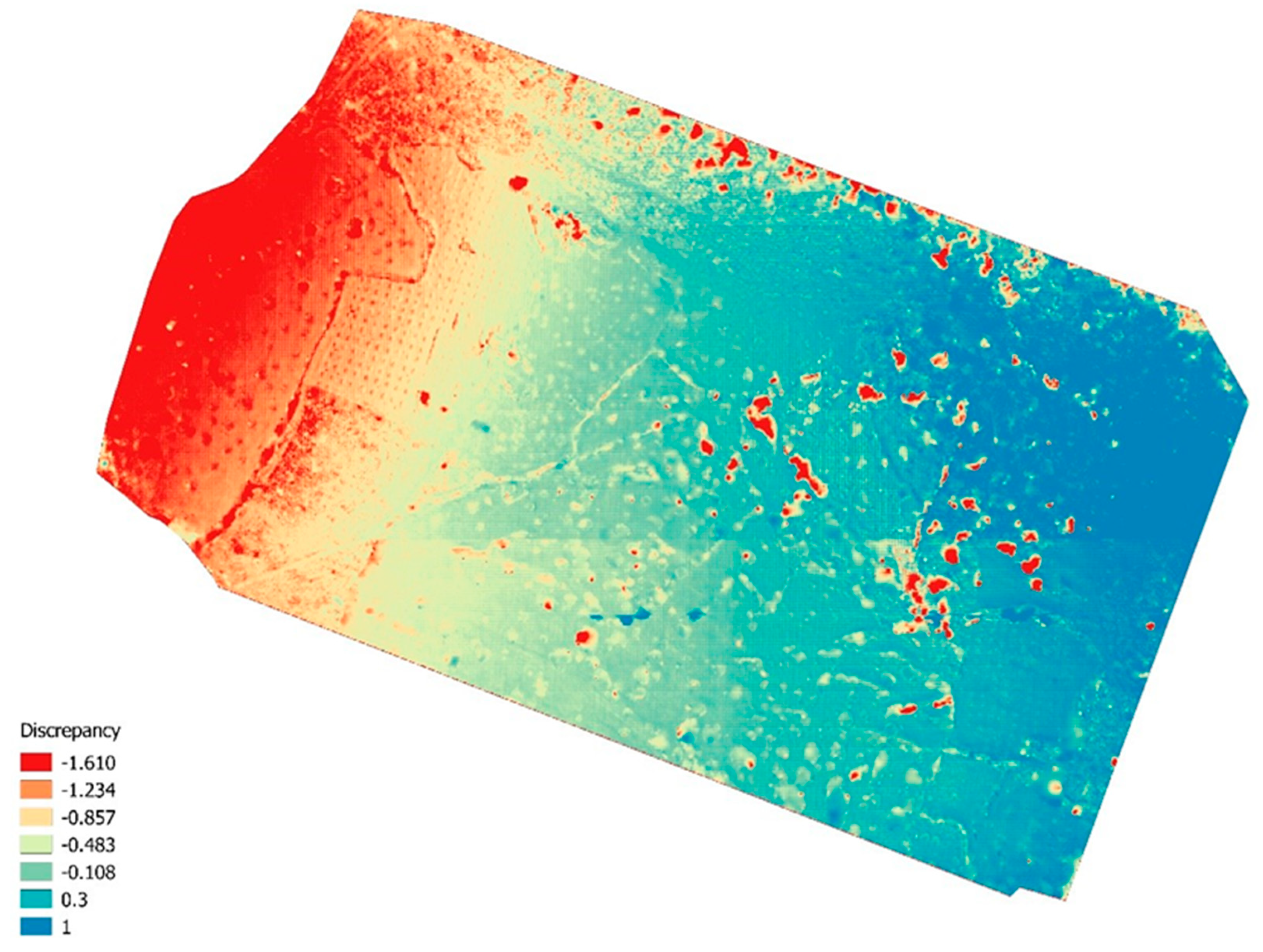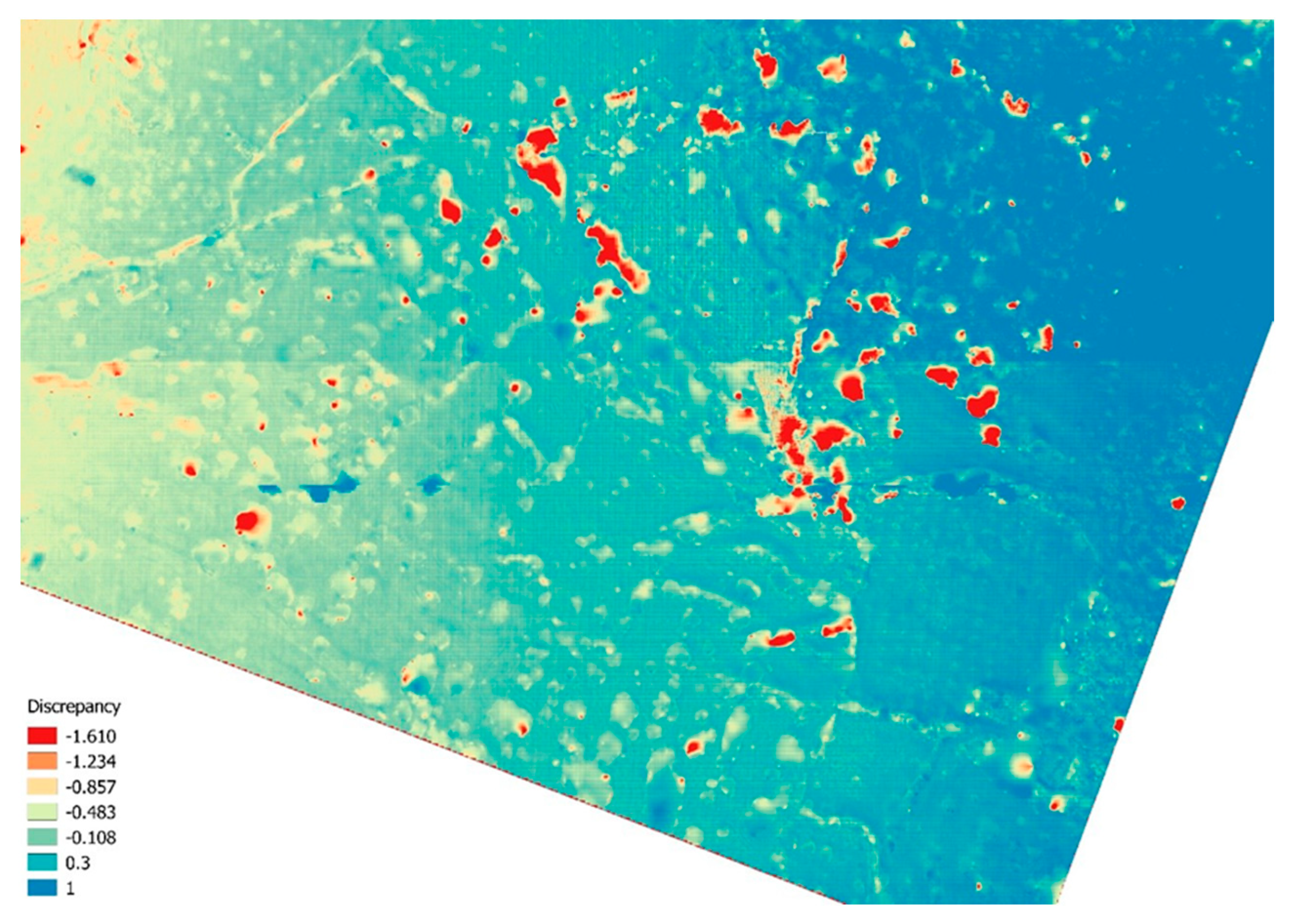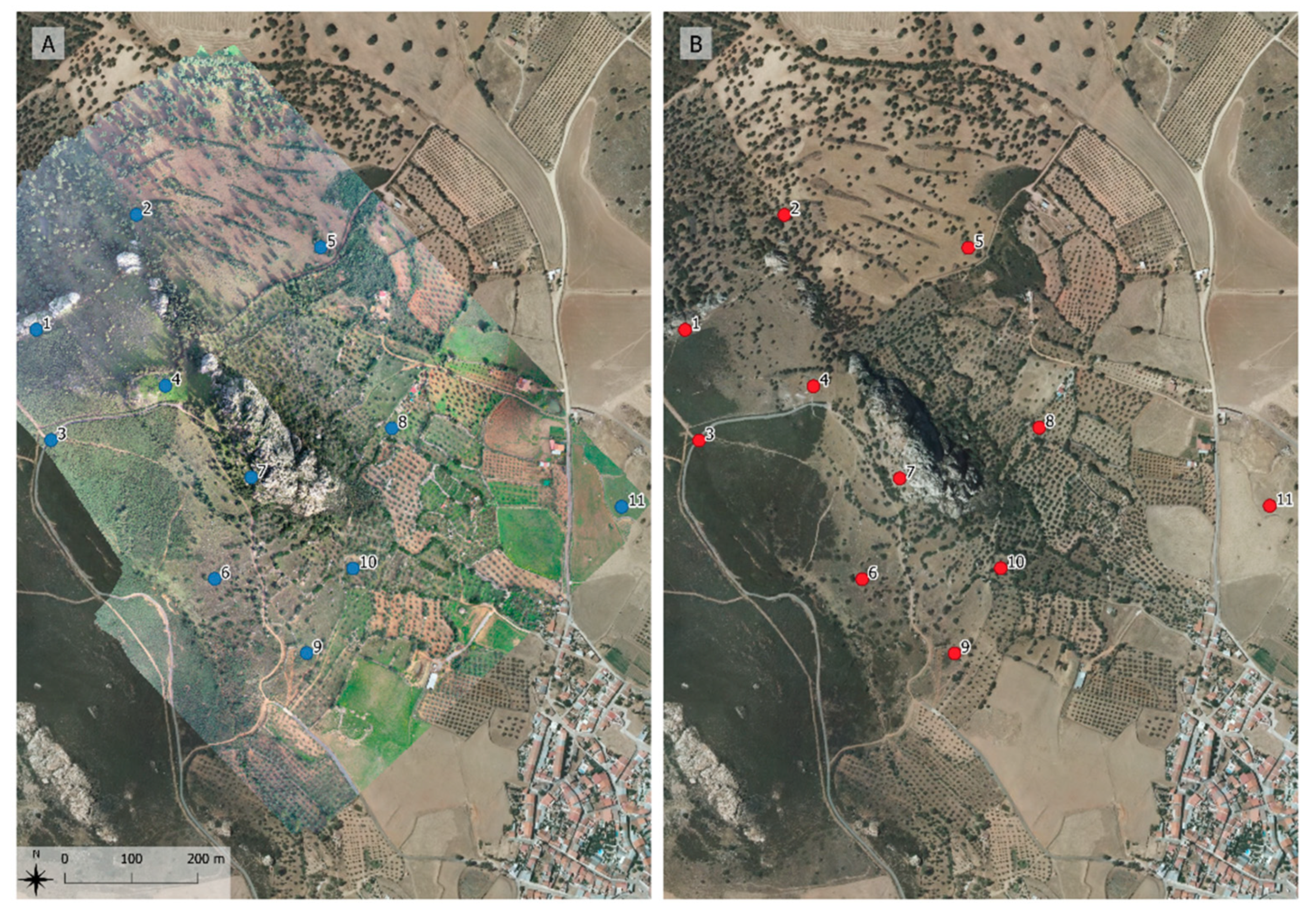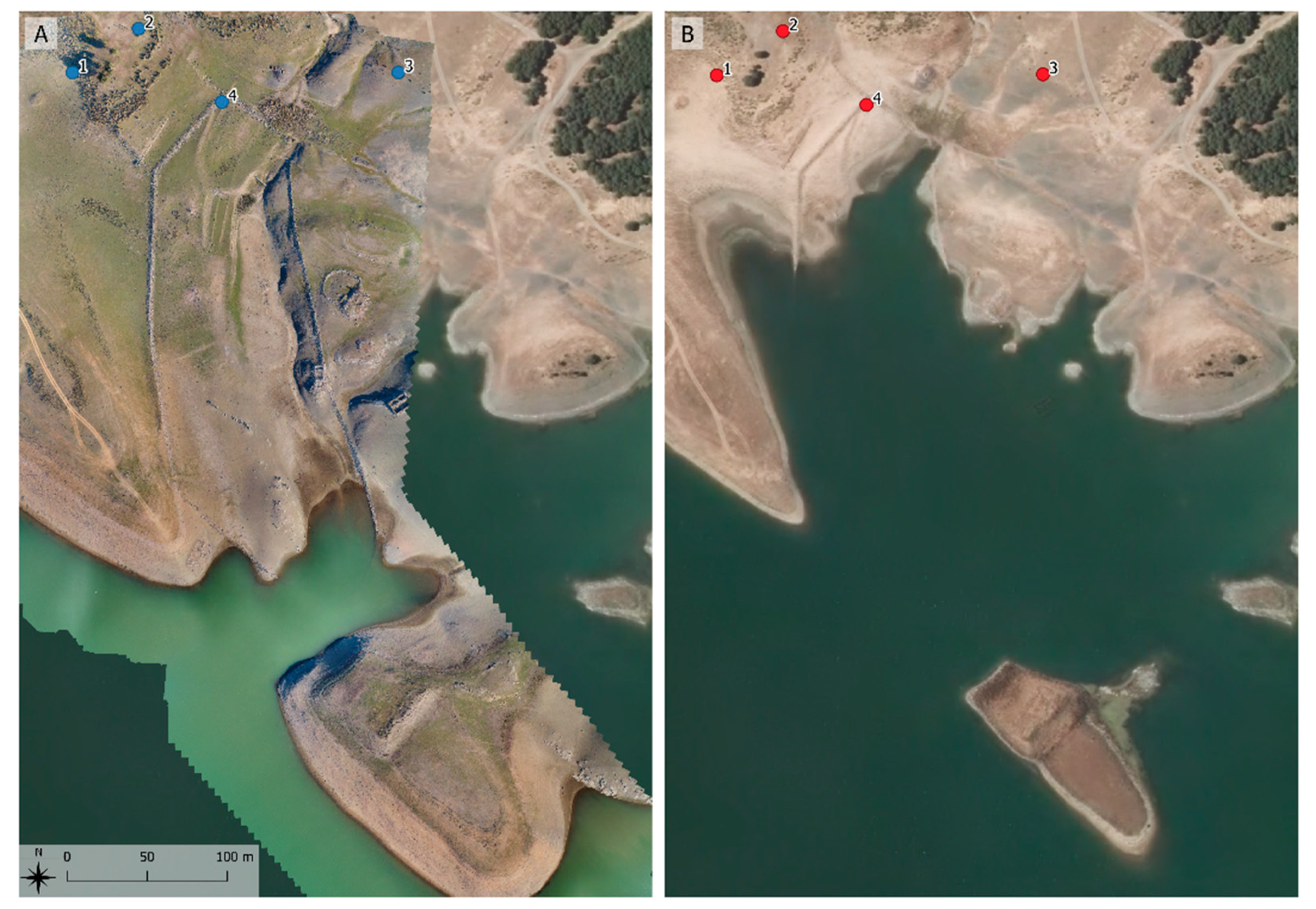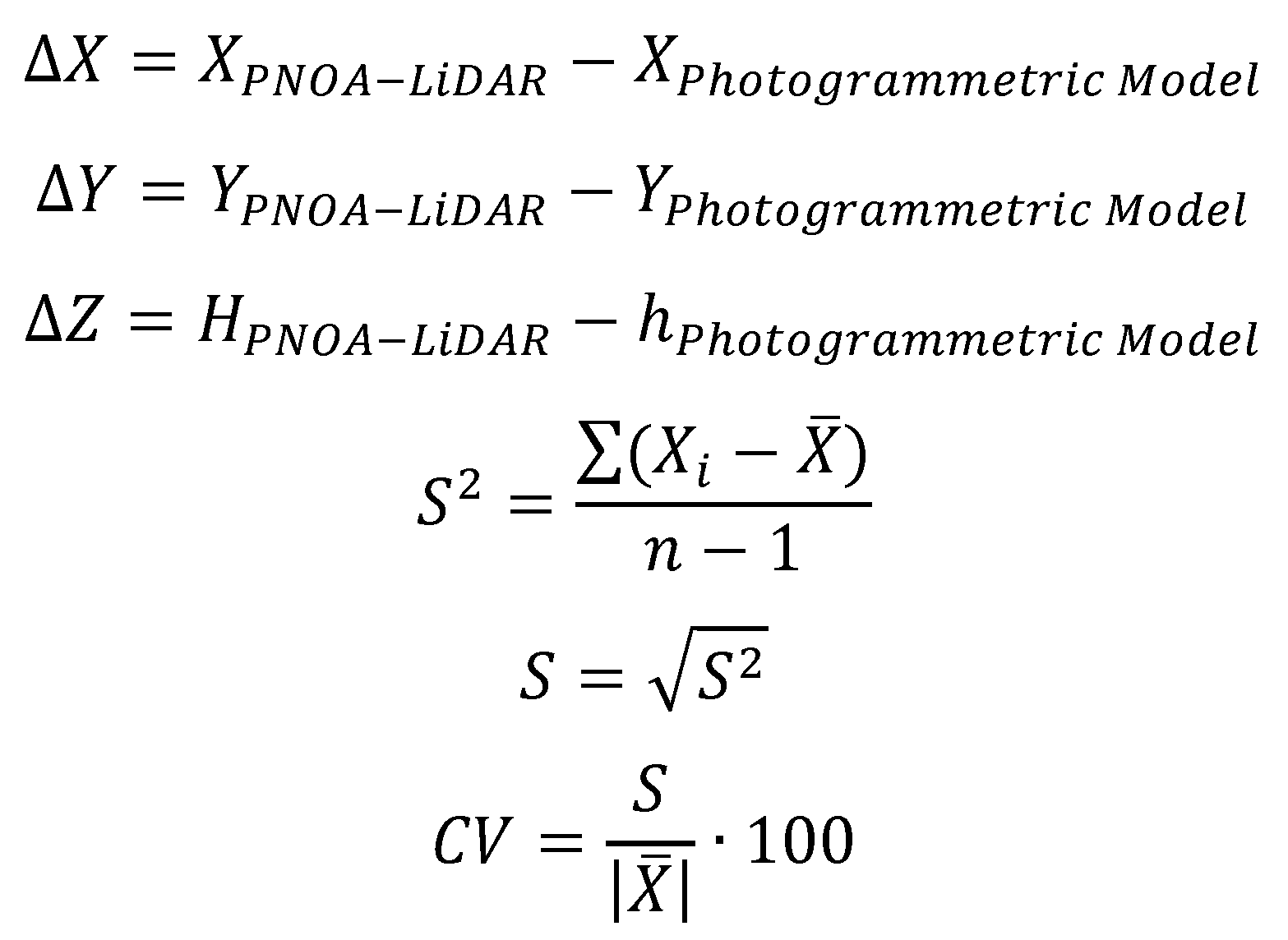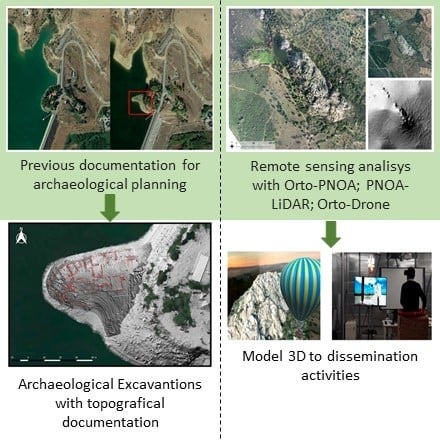Author Contributions
Conceptualization, M.G., J.C.M.-E. and A.M.-C.; methodology, M.G. and J.C.M.-E.; validation, M.G. and J.C.M.-E.; investigation, M.G., J.C.M.-E. and A.M.-C.; data curation, J.C.M.-E.; writing—original draft preparation, M.G. and J.C.M.-E.; writing—review and editing, M.G. and A.M.-C.; supervision, A.M.-C.; project administration, A.M.-C.; funding acquisition, A.M.-C. All authors have read and agreed to the published version of the manuscript.
Figure 1.
Geographical location of the five archaeological case studies. © “Ager Mellariensis”/AEI FEDER HAR 77136-R. Orthoimage from © IGN ORTO-PNOA 2016.
Figure 1.
Geographical location of the five archaeological case studies. © “Ager Mellariensis”/AEI FEDER HAR 77136-R. Orthoimage from © IGN ORTO-PNOA 2016.
Figure 2.
Tartessian settlement of Sierra Boyera. On the left, the area on 21 July 2016. On the right, the same area on 28 October 2017, showing the emerged site. ©Images from Google Earth.
Figure 2.
Tartessian settlement of Sierra Boyera. On the left, the area on 21 July 2016. On the right, the same area on 28 October 2017, showing the emerged site. ©Images from Google Earth.
Figure 3.
Orthophoto mosaic created by the photogrammetric workflow using photos acquired by Unmanned Aerial Vehicle (UAV) at a height of 20 m (area outlined in white) and the Ground Control Points (GCPs) used for the topographic survey (red). © “Ager Mellariensis”/AEI FEDER HAR 77136-R.
Figure 3.
Orthophoto mosaic created by the photogrammetric workflow using photos acquired by Unmanned Aerial Vehicle (UAV) at a height of 20 m (area outlined in white) and the Ground Control Points (GCPs) used for the topographic survey (red). © “Ager Mellariensis”/AEI FEDER HAR 77136-R.
Figure 4.
(A) Mina de la Loba. Extraction galleries and settlement. © “Ager Mellariensis”/AEI FEDER HAR 77136-R. (B) Orthophoto mosaic (left) and Digital Elevation Model (DEM) (right) of the final products of the Mina de la Loba photogrammetric survey. GCPs are marked in red. © “Ager Mellariensis”/AEI FEDER HAR 77136-R.
Figure 4.
(A) Mina de la Loba. Extraction galleries and settlement. © “Ager Mellariensis”/AEI FEDER HAR 77136-R. (B) Orthophoto mosaic (left) and Digital Elevation Model (DEM) (right) of the final products of the Mina de la Loba photogrammetric survey. GCPs are marked in red. © “Ager Mellariensis”/AEI FEDER HAR 77136-R.
Figure 5.
Orthophoto mosaic obtained by the photogrammetric survey of the caliphal fortress and Tolote settlement with the detected archaeological structures. © “Ager Mellariensis”/AEI FEDER HAR 77136-R.
Figure 5.
Orthophoto mosaic obtained by the photogrammetric survey of the caliphal fortress and Tolote settlement with the detected archaeological structures. © “Ager Mellariensis”/AEI FEDER HAR 77136-R.
Figure 6.
Orthophoto mosaic obtained by the photogrammetric survey of the caliphal fortress and village of Tolote. GCPs are marked in red. © “Ager Mellariensis”/AEI FEDER HAR 77136-R.
Figure 6.
Orthophoto mosaic obtained by the photogrammetric survey of the caliphal fortress and village of Tolote. GCPs are marked in red. © “Ager Mellariensis”/AEI FEDER HAR 77136-R.
Figure 7.
Peñon de Peñarroya: (A) orthophoto mosaic by UAV photogrammetric survey; (B) orthophoto mosaic of the year 2013 of the PNOA; (C) Digital Terrain Model (DTM) generated from the LiDAR files of the PNOA. © “Ager Mellariensis”/AEI FEDER HAR 77136-R.
Figure 7.
Peñon de Peñarroya: (A) orthophoto mosaic by UAV photogrammetric survey; (B) orthophoto mosaic of the year 2013 of the PNOA; (C) Digital Terrain Model (DTM) generated from the LiDAR files of the PNOA. © “Ager Mellariensis”/AEI FEDER HAR 77136-R.
Figure 8.
Venta de la Estrella (Espiel): (A) ©PNOA orthophoto mosaic of 2005; (B) orthophoto mosaic by UAV photogrammetric survey without an accurate topographic survey on the ground; (C) DEM by UAV photogrammetric survey. © “Ager Mellariensis”/AEI FEDER HAR 77136-R.
Figure 8.
Venta de la Estrella (Espiel): (A) ©PNOA orthophoto mosaic of 2005; (B) orthophoto mosaic by UAV photogrammetric survey without an accurate topographic survey on the ground; (C) DEM by UAV photogrammetric survey. © “Ager Mellariensis”/AEI FEDER HAR 77136-R.
Figure 9.
Tartessian settlement of Sierra Boyera Reservoir: topographic survey with TS (red) overlapped on the hillshade map by DEM. © “Ager Mellariensis”/AEI FEDER HAR 77136-R.
Figure 9.
Tartessian settlement of Sierra Boyera Reservoir: topographic survey with TS (red) overlapped on the hillshade map by DEM. © “Ager Mellariensis”/AEI FEDER HAR 77136-R.
Figure 10.
Graph of the height discrepancies (Δh) between the points of the topographic survey with TS and the corresponding pixels extrapolated from the DEM.
Figure 10.
Graph of the height discrepancies (Δh) between the points of the topographic survey with TS and the corresponding pixels extrapolated from the DEM.
Figure 11.
Formula used to calculate the root mean square error (RMSE) between the TS topographic survey and the photogrammetric DEM: n is the number of points (138), hTotal Station [m] is the height obtained by the TS and hPhotogrammetric Model [m] is the height obtained by the DEM.
Figure 11.
Formula used to calculate the root mean square error (RMSE) between the TS topographic survey and the photogrammetric DEM: n is the number of points (138), hTotal Station [m] is the height obtained by the TS and hPhotogrammetric Model [m] is the height obtained by the DEM.
Figure 12.
Mina de la Loba: map of discrepancies between the heights of the DEMs generated from the photogrammetric and LiDAR data. © “Ager Mellariensis”/AEI FEDER HAR 77136-R.
Figure 12.
Mina de la Loba: map of discrepancies between the heights of the DEMs generated from the photogrammetric and LiDAR data. © “Ager Mellariensis”/AEI FEDER HAR 77136-R.
Figure 13.
Caliphal fortress and settlement of Tolote: map of discrepancies between the heights of the DEMs generated by the elaboration of photogrammetric data and the PNOA LiDAR data. © “Ager Mellariensis”/AEI FEDER HAR 77136-R.
Figure 13.
Caliphal fortress and settlement of Tolote: map of discrepancies between the heights of the DEMs generated by the elaboration of photogrammetric data and the PNOA LiDAR data. © “Ager Mellariensis”/AEI FEDER HAR 77136-R.
Figure 14.
Caliphal fortress and village of Tolote: detail of the discrepancies map corresponding to the area where the historical structures are located. © “Ager Mellariensis”/AEI FEDER HAR 77136-R.
Figure 14.
Caliphal fortress and village of Tolote: detail of the discrepancies map corresponding to the area where the historical structures are located. © “Ager Mellariensis”/AEI FEDER HAR 77136-R.
Figure 15.
Section 2.5 Peñon de Peñarroya (Peñarroya–Pueblonuevo): (
A) Comparison of the spatial distribution of the sampling points used to evaluate the absolute errors between the orthophoto mosaic obtained by the photogrammetric survey and (
B) the Spanish PNOA orthophoto mosaic of 2016. A. © “Ager Mellariensis”/AEI FEDER HAR 77136-R. B. © IGN ORTO-PNOA 2016.
Figure 15.
Section 2.5 Peñon de Peñarroya (Peñarroya–Pueblonuevo): (
A) Comparison of the spatial distribution of the sampling points used to evaluate the absolute errors between the orthophoto mosaic obtained by the photogrammetric survey and (
B) the Spanish PNOA orthophoto mosaic of 2016. A. © “Ager Mellariensis”/AEI FEDER HAR 77136-R. B. © IGN ORTO-PNOA 2016.
Figure 16.
Section 2.6 Venta de la Estrella (Espiel): comparison of the spatial distribution of the sampling points used to evaluate the absolute errors between (
A) the orthophoto mosaic obtained by the photogrammetric survey and (
B) the Spanish PNOA orthophoto mosaic of 2016. A. © “Ager Mellariensis”/AEI FEDER HAR 77136-R. B. © IGN ORTO-PNOA 2016.
Figure 16.
Section 2.6 Venta de la Estrella (Espiel): comparison of the spatial distribution of the sampling points used to evaluate the absolute errors between (
A) the orthophoto mosaic obtained by the photogrammetric survey and (
B) the Spanish PNOA orthophoto mosaic of 2016. A. © “Ager Mellariensis”/AEI FEDER HAR 77136-R. B. © IGN ORTO-PNOA 2016.
Figure 17.
Coefficient of variation or relative standard deviation: is the arithmetic mean of the errors, Xi is the error of each sampling point, S2 is the variance, S is the standard deviation and CV is the coefficient of variation expressed in %.
Figure 17.
Coefficient of variation or relative standard deviation: is the arithmetic mean of the errors, Xi is the error of each sampling point, S2 is the variance, S is the standard deviation and CV is the coefficient of variation expressed in %.
Figure 18.
AeroGlobeGuadiatvr. Virtual tour of the Peñon de Peñarroya (and the medieval castle of Belmez) developed by Ramón González of Cetemet Inc. for the Ager Mellariensis research project.
Figure 18.
AeroGlobeGuadiatvr. Virtual tour of the Peñon de Peñarroya (and the medieval castle of Belmez) developed by Ramón González of Cetemet Inc. for the Ager Mellariensis research project.
Table 1.
Flight plan settings for the photogrammetric survey of the Tartessian settlement of the Sierra Boyera Reservoir.
Table 1.
Flight plan settings for the photogrammetric survey of the Tartessian settlement of the Sierra Boyera Reservoir.
| Survey Area | 0.21 ha |
|---|
| Flight level [m] | 20 |
| Flight airspeed [m/s] | 1.5 |
| Interval shooting [s] | 2 |
| GSD [cm] | 0.5 |
| Overlap [%] | 80 |
| Sidelap [%] | 75 |
| No. of photos used | 137 |
Table 2.
Flight plan settings for the Mina de la Loba photogrammetric survey.
Table 2.
Flight plan settings for the Mina de la Loba photogrammetric survey.
| Flight Plan 1 (N) | Flight Plan 2 (S) |
|---|
| Survey area | 11.5 ha | 12.7 ha |
| Flight level [m] | 120 | 120 |
| Flight airspeed [m/s] | 3 | 3 |
| Interval shooting [s] | 2 | 2 |
| GSD [cm] | 3.51 | 3.51 |
| Overlap [%] | >80 | >80 |
| Sidelap [%] | 75 | 74 |
| No. of photos used | 942 |
Table 3.
Flight plan settings for the photogrammetric survey of the caliphal fortress and village of Tolote (Los Blázquez).
Table 3.
Flight plan settings for the photogrammetric survey of the caliphal fortress and village of Tolote (Los Blázquez).
| Flight Plan 1 (N-S) | Flight Plan 2 (E-W) |
|---|
| Survey area | 13.9 ha | 13.9 ha |
| Flight level [m] | 120 | 120 |
| Flight airspeed [m/s] | 3 | 3 |
| Interval shooting [s] | 2 | 2 |
| GSD [cm] | 3.51 | 3.51 |
| Overlap [%] | >80 | >80 |
| Sidelap [%] | 75 | 75 |
| No. of photos used | 1109 |
Table 4.
Flight plan settings for the Peñon de Peñarroya photogrammetric survey (Peñarroya–Pueblonuevo).
Table 4.
Flight plan settings for the Peñon de Peñarroya photogrammetric survey (Peñarroya–Pueblonuevo).
| Flight Plan 1 (NW-SE) | Flight Plan 2 (NW-SE) | Flight Plan 3 (NW-SE) |
|---|
| Survey area | 14.6 ha | 14.2 ha | 13.2 ha |
| Flight level [m] | 120 | 120 | 120 |
| Flight airspeed [m/s] | 3 | 3 | 3 |
| Interval shooting [s] | 2 | 2 | 2 |
| GSD [cm] | 3.51 | 3.51 | 3.51 |
| Overlap [%] | 80 | 80 | 80 |
| Sidelap [%] | 70 | 70 | 70 |
| No. of photos used | 1442 |
Table 5.
Flight plan settings for the Venta de la Estrella photogrammetric survey (Espiel).
Table 5.
Flight plan settings for the Venta de la Estrella photogrammetric survey (Espiel).
| Flight Plan 1 (N-S) | Flight Plan 2 (NW-SE) |
|---|
| Survey area | 8 ha | 7 ha |
| Flight level [m] | 60 | 60 |
| Flight airspeed [m/s] | 1.5 | 1.5 |
| Interval shooting [s] | 2 | 2 |
| GSD [cm] | 1.4 | 1.4 |
| Overlap [%] | 80 | 80 |
| Sidelap [%] | 70 | 70 |
| No. of photos used | 1151 |
Table 6.
Results of the coefficient of variation for the 11 sampling points of
Section 2.5 Peñon de Peñarroya.
Table 6.
Results of the coefficient of variation for the 11 sampling points of
Section 2.5 Peñon de Peñarroya.
| Section 2.5 Peñón de Peñarroya |
|---|
| PNOA-LiDAR | Photogrammetric Model | Discrepancies |
|---|
| ID | X [m] | Y [m] | H [m] | X [m] | Y [m] | h [m] | ΔX [m] | ΔY [m] | ΔZ [m] |
|---|
| 1 | 299,616.631 | 4,243,949.724 | 713.802 | 299,614.541 | 4,243,949.990 | 702.86133 | 2.090 | −0.266 | 10.941 |
| 2 | 299,765.333 | 4,244,121.761 | 671.937 | 299,764.475 | 4,244,122.033 | 663.74713 | 0.858 | −0.272 | 8.190 |
| 3 | 299,637.708 | 4,243,784.115 | 728.181 | 299,636.869 | 4,243,784.750 | 717.70593 | 0.839 | −0.635 | 10.475 |
| 4 | 299,808.813 | 4,243,865.292 | 751.312 | 299,807.903 | 4,243,866.102 | 739.38873 | 0.910 | −0.810 | 11.923 |
| 5 | 300,040.827 | 4,244,072.587 | 678.150 | 300,040.528 | 4,244,073.300 | 668.81262 | 0.299 | −0.713 | 9.337 |
| 6 | 299,881.750 | 4,243,576.557 | 689.382 | 299,881.727 | 4,243,576.998 | 678.82715 | 0.023 | −0.441 | 10.555 |
| 7 | 299,938.088 | 4,243,727.442 | 745.590 | 299,936.486 | 4,243,728.995 | 735.17694 | 1.602 | −1.553 | 10.413 |
| 8 | 300,146.978 | 4,243,803.410 | 659.138 | 300,147.137 | 4,243,802.425 | 649.09106 | −0.159 | 0.985 | 10.047 |
| 9 | 300,020.231 | 4,243,465.479 | 657.916 | 300,019.602 | 4,243,465.947 | 647.19226 | 0.629 | −0.468 | 10.724 |
| 10 | 300,089.282 | 4,243,593.039 | 661.015 | 300,088.825 | 4,243,592.640 | 651.50317 | 0.457 | 0.399 | 9.512 |
| 11 | 300,492.183 | 4,243,686.371 | 625.294 | 300,491.164 | 4,243,684.860 | 613.41095 | 1.019 | 1.511 | 11.883 |
| [m] | 0.779 | −0.206 | 10.364 |
| [m] | 0.429 | 0.748 | 1.186 |
| [m] | 0.65487523 | 0.86514358 | 1.08901314 |
| CV [%] | 84.0857652 | 420.52936 | 10.5080206 |
Table 7.
Results of the coefficient of variation for the four sampling points of case study 2.6 Venta de la Estrella.
Table 7.
Results of the coefficient of variation for the four sampling points of case study 2.6 Venta de la Estrella.
| Section 2.6 Venta de la Estrella |
|---|
| PNOA-LiDAR | Photogrammetric Model | Discrepancies |
|---|
| ID | X [m] | Y [m] | H [m] | X [m] | Y [m] | h [m] | ΔX [m] | ΔY [m] | ΔZ [m] |
|---|
| 1 | 323,329.922 | 4,224,524.940 | 443.529 | 323,331.093 | 4,224,526.652 | 508.82272 | −1.171 | −1.712 | −65.294 |
| 2 | 323,371.264 | 4,224,552.508 | 444.987 | 323,372.46 | 4,224,554.039 | 510.1181 | −1.196 | −1.531 | −65.131 |
| 3 | 323,533.788 | 4,224,525.563 | 444.658 | 323,534.817 | 4,224,526.753 | 509.28793 | −1.029 | −1.190 | −64.630 |
| 4 | 323,423.451 | 4,224,506.473 | 443.624 | 323,424.532 | 4,224,508.301 | 505.87317 | −1.081 | −1.828 | −62.249 |
| [m] | −1.119 | −1.565 | −64.326 |
| [m] | 0.006 | 0.078 | 1.997 |
| [m] | 0.07783904 | 0.27842339 | 1.41306383 |
| CV [%] | −6.95457166 | −17.7877904 | −2.19672414 |
